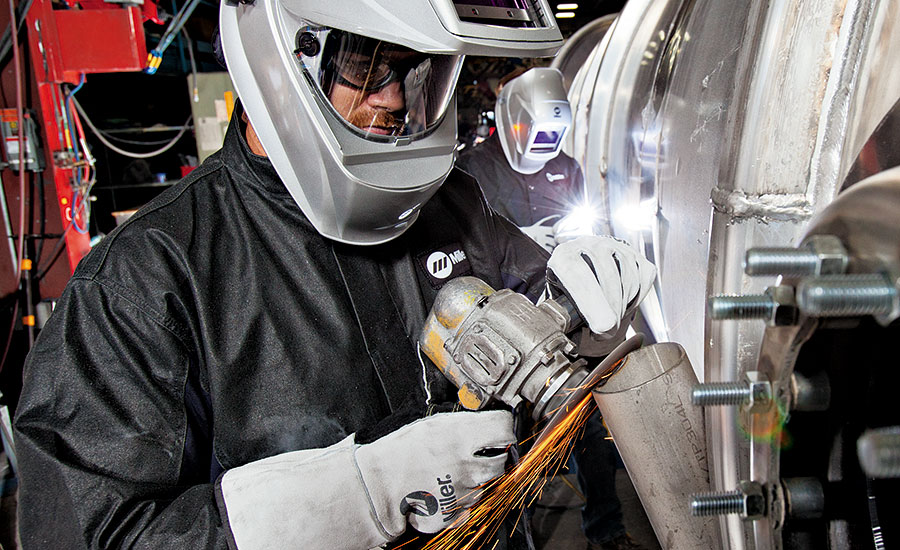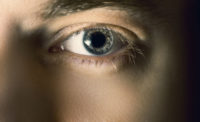Factors contributing to eye/face injury
The 2014 U.S. Bureau of Labor Statistics (BLS) reports that today’s workforce employs over 350,000 welders, cutters, solderers and brazers in a wide variety of industries, each presenting its own safety hazards. The American Welding Society mentions that U.S. Government agencies estimate over 2,000 eye injuries occur each day that require medical treatment, and 1,000 eye injuries occur in the industrial workplace alone.
BLS found that almost 70 percent of the eye injuries studied occurred from falling or flying objects, or sparks striking the eye. A typical welding operator is exposed to these hazards from various sources: exposure to the intensity of visible light, flying sparks and spatter, harmful radiation from arc welding, burns on exposed skin, airborne slag chips, grinding debris from cleaning and finishing the welded product.
Although operators often wear safety glasses, goggles or helmets, studies have shown most injuries are caused by not wearing eye protection or wearing the wrong eye protection for the application. The cost of noncompliance is significant. These injuries alone cost U.S. businesses over $900 million dollars annually in direct costs such as medical bills, workers’ compensation, lost wages and production.
Injury prevention
Experts agree nearly 90 percent of these injuries could be prevented with appropriate eye and face protection. OSHA requires the elimination of hazardous conditions in the workplace. When engineering or administrative controls are not feasible or effective in reducing these exposures to acceptable levels, personal protective equipment (PPE) is designed to prevent or lessen the severity of injuries.
Selection & best practices
Make sure selected protection is appropriate for your workplace hazards and is approved by the American National Standards Institute, ANSI Z87.1 – 2010 — ensuring the helmet and lenses have passed independent testing for impact, UV/IR filtering, and switching speeds, and shade darkness. Refer to the OSHA Eye and Face Protector Selection Guide and the Eyewear Applications Guide for recommendations based upon workplace operations and hazards. Select protection based upon meeting regulatory standards, specific workplace hazard requirements, operator performance and comfort.
A provision in the ANSI-Z87.1 standard requires basic eye protection, such as safety glasses or goggles, in addition to the welding helmet.
Assess your workplace hazards and injury statistics to provide the most appropriate eye and face protection to reduce exposure to the hazards. For example, if eye injuries are caused by radiation from other welders in the area or from reflections of arc rays, use perimeter safety curtains and weld screens to protect others from being subjected to the arc flash. Those who may still be exposed to arc flash should wear protective eyewear with filter lenses.
Train employees on selection of equipment for their specific welding application. Include instruction on the proper use, maintenance requirements, storage, and replacement or repair.
Eye/face protection
Safety glasses, welding helmets and goggles are the most commonly recommended eye and face protection in welding, cutting and brazing operations. Welding and cutting goggles should have impact-, abrasion-, and flame-resistant frames and impact-resistant filter lens with a shade suitable for the welding process application. These should also provide a snug, but comfortable fit and allow indirect ventilation for circulation of airflow and anti-fogging of lens while keeping heat, debris and radiation out.
Helmets are essential for protecting eyes and skin from exposure to arc rays, heat, debris and sparks or spatter in the welding process. Choose the right shade lens for your welding process. Manufacturers’ manuals or the ANSI Z49.1 standard provide selection guides based upon electrode, amperage or welding process. Begin with a darker filter lens and gradually change to a lighter shade until you have good visibility at the puddle and weld joint, and are not experiencing eye irritation or discomfort. The filter lenses are designed to protect the welder from visible and invisible (ultraviolet and infrared) rays that are emitted from the welding arc. Welding caps or helmet bibs also protect the welder from sparks and spatter that find their way behind the helmet or underneath the hood.
Welding helmets & filtering lenses
Today’s welding helmets offer a wide range of darkening shades, sensitivity controls, reaction speeds and other features to accommodate any welding application and budget. Auto-darkening technology found in modern welding helmets eliminates the need to flip the helmet up and down to reposition work material, reducing neck strain and potential injury. Different models have multiple arc sensors that help when welding out of position. Increased controls offer improved comfort and compliance by allowing the welder to adjust their settings based upon personal preferences and light sensitivities. Features such as grind mode, multiple arc sensors and delay controls further ensure maximum protection before, during and after welding.
Choose the material and shape of the helmet and visor for the appropriate welding process, working conditions and environment. Many welding helmets have a grinding shade or incorporate a flip-up welding shield with an integrated, impact-resistant, clear grinding shield. A few welding helmets have a heat-reflective coating and aluminized heat shield on the lens for high-amperage welding, improving lens durability and welder comfort in high-heat welding applications. Helmet comfort, balance and stability are delivered through the headgear, another feature that varies greatly in welding helmet options.
New technology
A recent advancement in auto-darkening helmet technology involves the electromagnetic detection of the weld. Historically, welding helmets would only use optical sensors that reacted to the light of the weld. Helmet lenses with this technology respond more consistently to protect the welder’s sight and activate more efficiently in low amperage (TIG) welding processes and eliminate interference from direct sunlight.
There are times when a welding helmet is not optimal for a working environment such as specialized applications, tight-fitting areas, and where background lighting or sunlight interferes with the auto-darkening lenses. A recent introduction of an auto-darkening weld-mask goggle with anti-spark and spatter face shield, and full flame-retardant head covering can be used as an alternative to standard welding helmets or hand-held filters.






